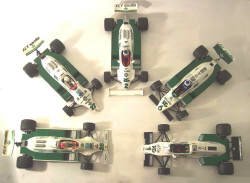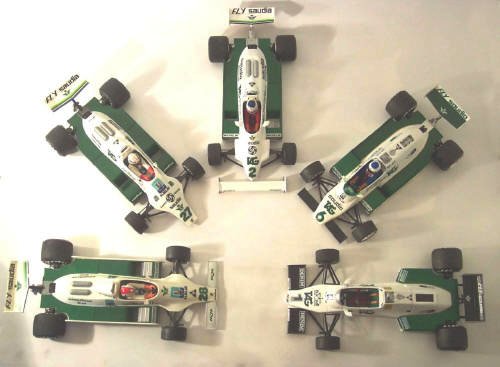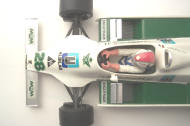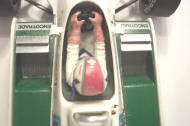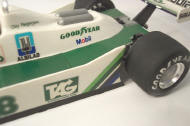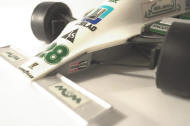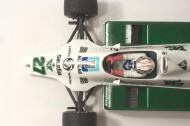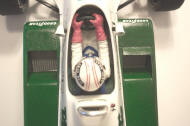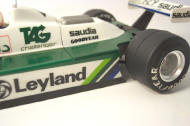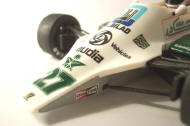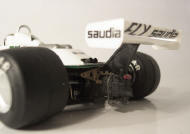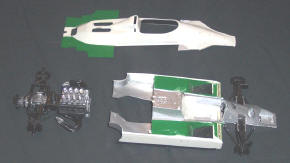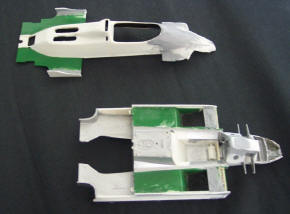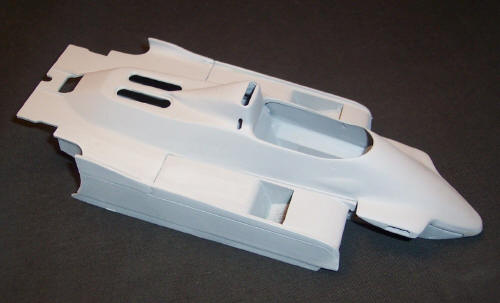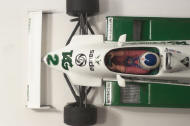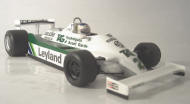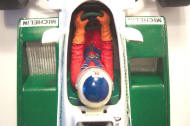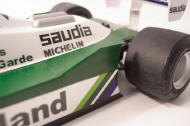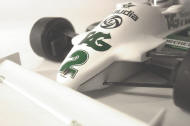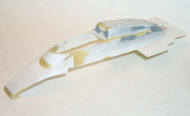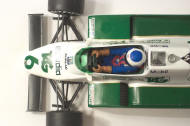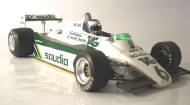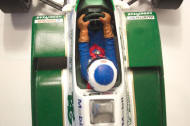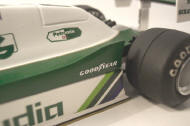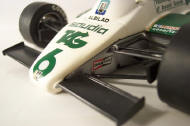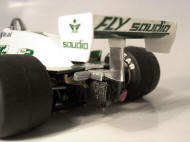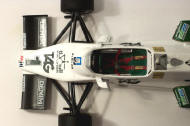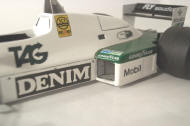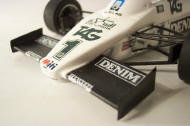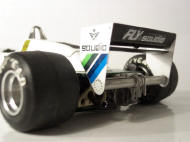|
Formula one |
|
|
The Williams-Ford's history 1979 to 1983 |
|
|
by Jens Martin © 2005 Modeler Site |
|
|
Legal Notice No material from Modeler Site any Web site owned, operated, licensed, or controlled by Damian Covalski may be copied, reproduced, republished, uploaded, posted, transmitted, or distributed in any way, except that you may download one copy of the materials on any single computer for your personal, non-commercial home use only, provided you keep intact all copyright and other proprietary notices. Modification of the materials or use of the materials for any other purpose is a violation of Damian Covalski's copyright and other proprietary rights. Read More here > Legal notice Building Formula-1 model cars for me has a double fascination. On one hand it gives me pleasure (well - most of times) to put together tiny bits of plastic, resine or metal to assemble miniature copies of most sophisticated vehicles – Grand Prix cars. On the other hand I am always interested in the story behind the model – who had driven the original car, in which races did it compete, which results were achieved with it etc. Most of the cars I built I can relate to, having followed their races on radio and television and during the last few years even live on the racetracks. So the reason for choosing a certain kit for me has always to do with the history of it’s original. For example the Williams cars of the late seventies and early eighties are special to me because I started to get interested in Formula 1 towards the end of 1979. Jody Scheckter had just won the World Championship – the last Ferrari driver to do so for more than two decades as it would turn out. Niki Lauda had retired for the first time and Williams had dominated the second half of the championship of 1979 with Alan Jones winning four of the last six races. For me Williams then was synonymous with a successful Grand Prix team which was favorite to carry away the title honors for 1980 – the first Formula-1 World Championship I was to follow over a complete season. What I did not acknowledge then was the fact that Frank Williams’ team until two year earlier had been scraping on the edge of survival. So my beginning fascination of Grand Prix racing went along with the emergence of Williams as front runners.
More than ten years later when building Formula-1 model cars became a hobby for me, one of the first 1/20 kits I ever built was Tamyia’s Williams FW07. During the last two years I have built models of the four follow up cars Williams produced and raced up until 1983. This gave me the idea to write a small story about the Williams cars of this era and the models.
1979 Williams FW07 – The Emergence of Williams For about a decade Frank Williams had tried to succeed as an entrant in Formula-1, achieving only little in terms of results. The year 1978 marked a turning point for the better. Frank had secured sponsorship from Saudia and formed the partnership with designer Patrick Head who’s first Williams design - the FW06 - gave the team 9th place in the makes championship and Australian Alan Jones 11th in the drivers championship.
The FW06 carried on for the first races of 1979 when Williams had expanded to two cars with Clay Regazzoni joining Alan Jones. From the Spanish Grand Prix onwards the Williams FW07 came into service. It perfected the wing-car principle which had made Lotus all conquering in1978. The first success for Williams came at the British Grand Prix with Clay Regazzoni winning after Alan Jones dropped out with an engine failure while leading. Jones then won the next three races in Germany, Austria and the Netherlands and later another one in Canada. He ended up third in the drivers world championship while Williams was placed third in the makes table. 1980 Williams FW07B – The first Williams World Champion After Williams’ superiority during the second half of 1979 the team and it’s lead driver Alan Jones started 1980 as favorites for both the drivers and the makes title and lived up to the expectations. Jones won five races with the Williams FW07 and the FW07B on his way to the drivers title. His new team mate Carlos Reutemann was successful once and finished third in the championship. Williams won the constructors title. 1981 Williams FW07C – Second Constructors Championship The 1981 was the third year for the Williams FW07 now in its C-Specification. The season started as 1980 had ended with a 1-2 victory for Jones and Reutemann in Long Beach. But the harmony within the team was disturbed when Carlos Reutemann won in Brazil thereby ignoring team orders. The Argentinean later won another race in Belgium and by mid season looked destined for championship glory. But during the last races his title challenge fell apart and he was beaten by Nelson Piquet who won his first title with Brabham. Alan Jones won the last race of the season and then announced his retirement (he would un-retire twice with little to no success). The Williams FW07C had propelled Reutemann to second and Jones to third in the drivers championship standings while the team won its second constructors title in succession. 1982 Williams FW08 – Last of the Cosworth Champions Williams started the 1982 season with an updated version of the FW07 driven by Carlos Reutemann, who originally had retired after the disappointment at the end of 1981 but then stayed on, and Keke Rosberg who replaced Alan Jones. While Reutemann retired for good after only two races Rosberg soldiered on with the FW07 and from the Belgian Grand Prix onward with the FW08 and became a contender for the drivers title. In a turbulent and tragic season which saw the deaths of Gilles Villeneuve and Riccardo Paletti Keke won just one race - the Swiss Grand Prix in Dijon. But that one victory, a string of podium finishes and other point scoring races were enough for him to be crowned world champion. He was to be the last champion with a normally aspirated engine before the turbo cars took over. 1983 Williams FW08C – Struggling against the Turbos In 1983 Williams as all teams without a turbo engine had no chance in the championship. The Williams FW08C was a development of the 1982 FW08. Rule changes called for a flat car bottom as the wing car underbodies were outlawed. So the big wing shaped bottom area was not necessary anymore therefore the FW08C had much shorter sidepods. While Brabham, Renault and Ferrari fought for the title the highlight of Williams’ season was Keke Rosberg’s win at Monte Carlo. The Finn had started the race on a wet track using slicks, stayed on the road while it dried out and won while the other drivers had to change their tires to dry ones. Only one podium finish was to follow for Rosberg at Detroit. His team colleague Jacques Laffite’s season went far worse with only a few points finishes. Sometimes Laffite failed even to qualify. At the last race at Kyalami Williams tried it’s first Honda powered turbo car with Rosberg bringing it home in fifth place. The Williams-Honda combination was to go on to great success during 1985 to 87. The models Williams FW07 My FW07 model is from Tamyia and I built it straight out of the box. It was only my second 1/20 scale Grand Prix model. I choose the Clay Regazzoni version representing the car which won the first Grand Prix for Frank Williams’ team in Silverstone. There is not much to say about the building process as I just followed the excellent Tamiya instructions and didn’t change or add anything. Williams FW07B The 1980 FW07B was my first try at converting a kit into a different version. The main modification were made to the side pods and their upper radiator outlets as the sidepods didn’t have the fins anymore and the outlets had another size. The other difference where the decals. Some of the necessary decals are provided with the original Tamyia kit. The missing decals were printed using an inkjet printer and “Experts-Choice Decal Film”. Microscale liquid decal film made the decals durable. The model represents the Alan Jones version from the Belgian Grand Prix where the car run without front wings which was quite common for ground effect Formula 1 cars at that time. Making a version representing the later stages of the season would require different rear view mirrors and an altered rear wing support. Williams FW07C The conversion of another Tamyia FW07 into the 1981 “C” specification was made from an already built kit which was part of a model scrap yard I bought at eBay. I dismantled the model as far as possible and altered the front area using Tamyia Epoxy Putty and Putty paste. The car’s front end is shorter and more rounded compared to it’s predecessors. To get the shape right I used lots of reference pictures from sources which are listed at the end of this article.
The shape of the side pod sideplates was changed compared to the FW07B and was more like at the FW07 original version with fins again, while the upper radiator outlets stayed quite similar to the FW07B.
The rear wing support was altered as well. The rearwards angled support beam used with the FW07 and the early FW07B versions had to be replaced with a scratch built upright one which is mounted differently at the gearbox. I cut and filed these parts from plastic bits of different origins. Furthermore the rear wing endplates are bigger than the ones provided with the original kit. They can be made quite easily using plastic sheet material offered at modeling shops in different thickness.
I had to scratch built the rear view mirrors completely which was quite a hard job as it is difficult to file and sand such small parts and make two of them in identical but mirrored shape.
The version I built represented the car driven by Carlos Reutemann victoriously at the Belgian Grand Prix in Zolder. This early version sported a single piece front wing mounted on a support beam in front of the car’s snout. The wing was scratch built using plastic sheet material which I heated and bent and then filed and sanded to give it the wing shape.
As with the 1980 FW07B version additional decals were needed which were self-made in the same manner. Interestingly the car used Michelin tires during the first half of the season which means that kit’s tires with the Goodyear pattern cannot be used. I used the Michelin tires of a Tamiya Ferrari 312T3 kit (I know – the size is not exactly right but its good enough for me.) A Studio 27 seatbelt set was used for a little more detailed finish. Williams FW08 For the 1982 Williams FW08 I heavily modified another Tamyia FW07 kit. It was somehow hard to cut and break a new kit. During the building process it sometimes looked quite sorry! The shape of the car’s front is very different to the FW07 so I cut the frontal upper cowling off completely leaving only the cockpit edge. Then I scratch built the frontal area using plastic sheet material and Tamyia Epoxy Putty relying again on reference pictures. The lower chassis front was shaped with plastic sheets. Then I fitted them together without gluing and started filing and sanding the cowling and the joints until the finish satisfied me. The engine area of the cowling was formed with plastic sheets and Epoxy Putty and then required filing, sanding, reshaping, filing and sanding again and again…
While the rear suspension is quite similar to the original kit the upper front suspension had to be scratch built completely. I used plastic and white metal suspension parts left over from other kits and my “1/20 scale scrap yard” to do so. I am afraid I didn’t do it quite properly. My finished model sits a bit too low at the front.
The side pod side plates and the upper radiator outlets are again altered slightly compared to the FW07C and I shaped it – you might guess – using plastic sheet, putty, a file and sanding paper again.
The rear end, especially the rear wing mounting is similar to the FW07C and the wing support beam was scratch built in the same way as described above. The wing endplates are cut out from plastic sheet again. The roll-over bar is different from the predecessor cars and I made a new one cutting it from plastic sheet material and bending it in shape.
My biggest problem with this model conversion were the wheels. In 1982 Williams used wheels with eight spokes whereas the Tamyia kit provides four-spoke front and six-spoke rear wheels. I drilled the spokes away and cut new wheel centers from plasticard, drilling and filing the eight-spoke shape and then inserted the parts into the drilled out wheel rims again. I consider the wheels as worst part of my modifications as I did not manage an even shape and the dimensions somehow don’t seem right. Maybe one day I will make new wheels for this model or use some after marked parts to make it look better.
The rear view mirrors were again difficult to produce. Same story as with the ones for the FW07C. They should be similar but put beside each other they look different. A new set could be made at a later time.
My model represents the car driven by Keke Rosberg to his one and only victory of the season in Dijon. In this race the car sported front wings for which I used the ones provided with the original kit just fitting it to the altered shape of the car’s front and adding some slightly bigger endplates. As with the FW07C I used Studio 27 seatbelts for a nice finish of the drivers figure. For the cockpit windshield I simply used a piece of a green plastic bottle.
Most of the decals had to be self made – the difficult part here is to get the right green color typical for the Williamses of that time. For the green parts of the side pods I always used the decals provided with the kit and the self made decals have to match that special green. The golden lines between the green and white areas of the cowling were made with stripes cut from golden decal sheets which I got from a model online shop. Williams FW08C Initially I planned to make my 1983 FW08C as a conversion of another Tamyia FW07 kit but I then found that AMD in Brazil offered a full kit of that car. So I decided that saving a lot of time for not having to shape, file and sand the chassis, cowling and suspensions was worth an substantial increase of my budget and so I got one of the AMD kits.
The model is provided as a multimedia kit with resin, white metal and photo etched parts. The quality of the parts is very good, in my view it is comparable to Studio 27 kits, everything fits well together.
I built the kit straight out of the box in Rosberg’s successful Monaco version. For me the kit provides enough detailing so I didn’t add anything. The kit has of course the right eight-spoke wheels and the properly shaped rear view mirrors I struggled to make myself for the above mentioned FW08 and FW07C conversions. And surprise, surprise I had to find out that I now had the third version of mirrors that should in reality be identical. I surely must do something about it in the future!
The instruction consists more or less of five explosion drawings which for a modeler with a little experience is enough. Building the kit does not provide any difficulties. The decals supplied with my kit needed decal softer to be applied properly but they are alright. The kit does not provide decals for the green side pod areas so I used some from a Tamyia FW07 kit again. Conclusion and outlook This was the story about the successful Williams-Ford era of the late seventies and early eighties and my efforts to represent these cars in 1/20 scale. The models were built over a period of more than ten years and show my modeling skill’s development. There are models build straight out of the box and models with more or less modifications and scratch building. Especially the modifications have some flaws (yes: the wheels, the mirrors!!) but in the end I like them all even if perfectionists might have some reservations. What counts to me is that I created myself a scaled down piece of Formula One history I can relate to, having followed it then with great interest.
Currently I am about to extend my Williams model range towards the middle and late eighties. I already built the Tamyia kit of the 1986 FW11 and I have started to modify another of these kits into the 1985 FW10 which brought Nigel Mansell his first success in Formula One. Furthermore I am building the FW09 kit from Kawai which needs lots of modification to make it a realistic model.
What I still want to add to this line of Williams cars is the FW06 of 1978 – the first Patrick Head designed Williams. On the AMD homepage there is an announcement that they intend to release such a kit in the future. Let’s hope it doesn’t take too long. References Among other sources such as several motor sport magazines and internet sites I relied on reference pictures of the following books
Support us ordering our notes in PDF > Here |
|

